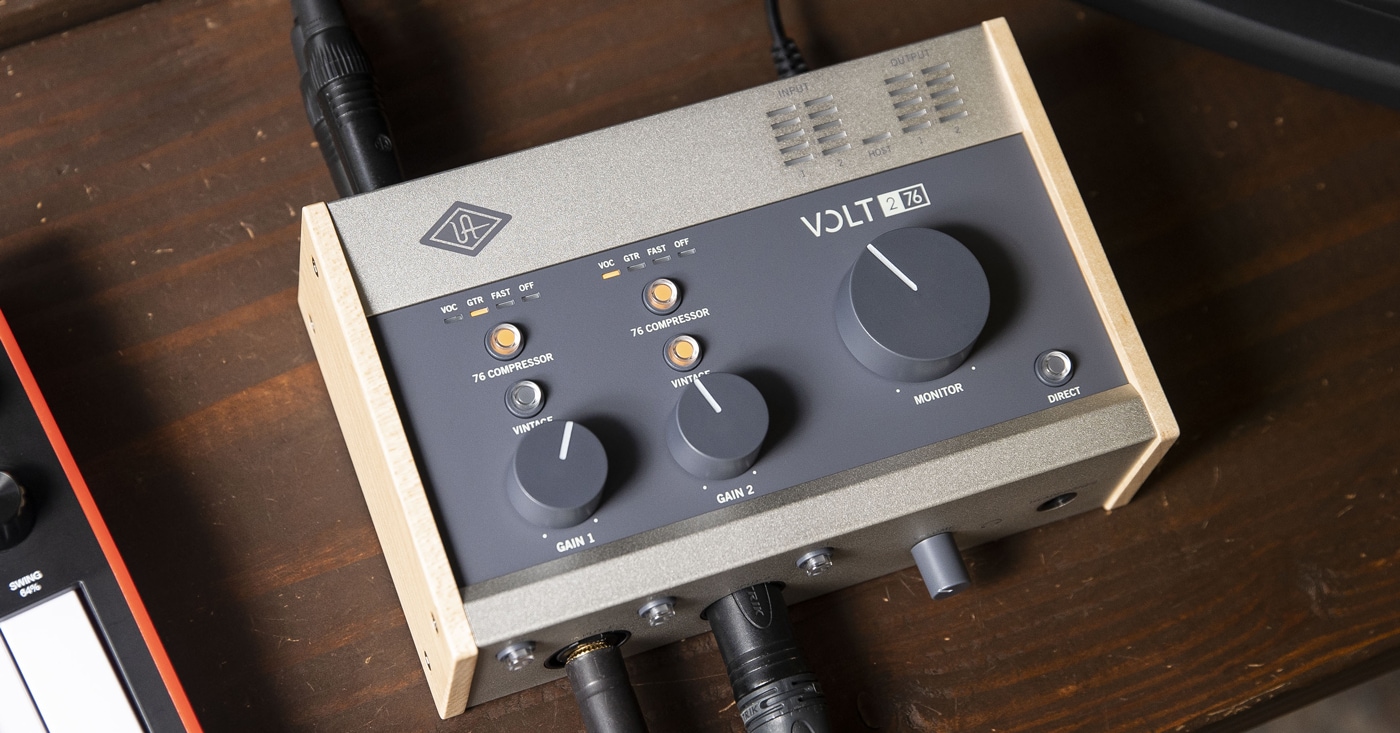Expanding on their legacy of legendary recording gear, Universal Audio set out to empower home studio recordists and musicians with their Volt series of USB audio interfaces. Designed by the same team of engineers that works on their iconic analog outboard gear and industry-standard Apollo X series, they thoughtfully devised a set of tonal, functional and aesthetic features—with the needs of modern production in mind.
Boasting vintage-inspired preamp voicing, Volt interfaces take cues from the celebrated 610 preamp—while the 76 models feature 1176-style compression. With their host of powerful plug-ins, Volt interfaces give users the sound and feel of classic UA gear in a desktop format that’s more accessible than ever.
We spoke with Shawn Ellis, director of hardware products at Universal Audio, to get an insider’s rundown on the creation, features and ethos of the Volt family of interfaces.
Can you explain how Volt came about and how it continues that long, rich UA legacy?
Shawn Ellis: At a fundamental level, we strive to be the way that people make music. We think of Volt as a way to reach even more musicians, producers and engineers that may not have been part of the UA family until now. It’s really about expanding the reach of what we can provide to people who are interested in making music—and other audio content.
When asked, "How can we reach those people?" we thought about what’s important to those users, and how Universal Audio could satisfy those needs. And that's how we came to the combination of features we have on the new Volt line.
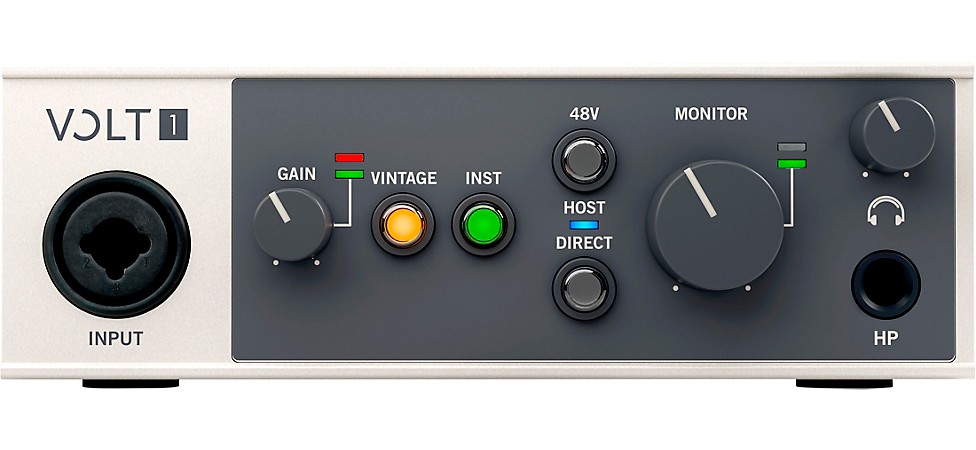
Pictured: Universal Audio Volt 1
Design-wise, can you take us from the outside-in on these?
Ellis: With all our products, we spend a lot of time thinking about the design, thinking about the exterior. It has to look great. It has to put a smile on your face. It has to have a timelessness to it. When you are using something that's beautiful and puts a smile on your face, inevitably, you're going to be happier. And when you're happier, you're going to be more creative. That was really important. Bringing in things like the wooden sides on the Volt 176, 276 and 476 adds a sense of organic warmth. It blends well with these darker greys and other metallic colors. We wanted it to be inviting and easy to use.
We think about the layout and color of the buttons. The brightness of the LEDs, the knobs and buttons in line—all of that was very thoughtfully laid out to be easy to use, to not get in your way, to be beautiful and intuitive. That really was important across all five Volt products.
Tell us about the differences between the Volt and Volt 76.
Ellis: One is design. Volt 1 and Volt 2 have all of the user interface on the front. All the buttons, knobs, combo input jacks, etc. are on the front. On the top, we have the logo, and then on the back is where the monitor output, MIDI, power switch, etc. are.
On the Volt 176, 276 and 476, the design is a bit different, with controls split between the front and top panel. You also have more advanced metering on the top panel of the 76 models.
From a feature perspective, the Volt 1 and Volt 2 both have the “Vintage” mic preamp mode. But the Volt 176, 276 and 476 also have the 76 Compressor. So, from a feature perspective, that's a big difference. There's the design difference, and then there's the “Does it have the 76 Compressor or not?” difference.
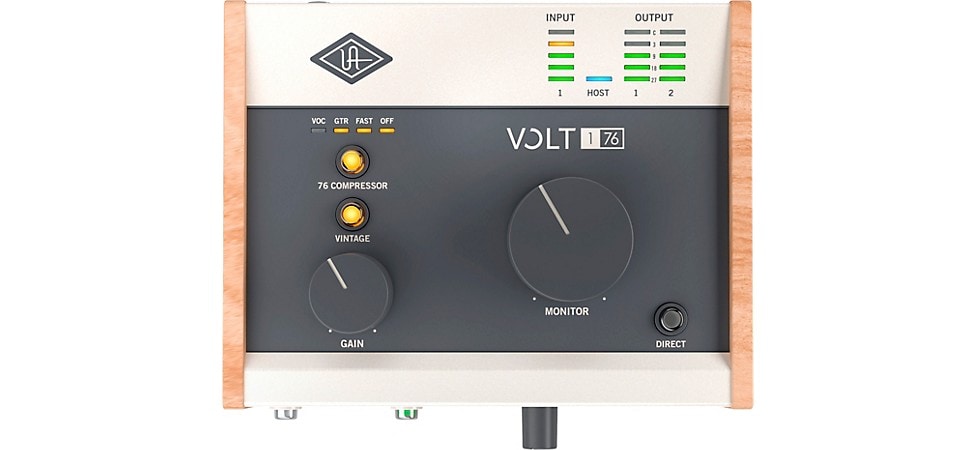
Pictured: Universal Audio Volt 176
Can you talk us through the features on the Volt 1? Who would it work well for?
Ellis: It’s simple in that it has a single input channel, and so it’s probably more suited for people that want to do some vocal or voice work, or maybe just record their guitar or bass. The simplicity of Volt 1 allows you to focus on one thing at a time. But because it has the Vintage mic pre circuit in it, you can still get a very rich, warm, tube-like sound when you engage it.
And moving up to a Volt 2 means adding an input?
Ellis: That's right. With the Volt 1 and 2, the difference is having one channel versus two channels. And it’s the same difference when looking at the Volt 176 and 276.
Can you talk a little more about how the Vintage mic pre mode sounds compared to the standard voicing?
Ellis: The Vintage mic pre mode is engageable, meaning you can turn it on or off depending on what kind of sound you're going for. With it turned off, you get pristine sound through the very high-quality converters and circuitry. But when you engage the Vintage mic pre mode on any of the Volt products, you get a sheen and warmth. It feels like there's depth—again, very tube-like. It's inspired by a classic that Universal Audio created back in the day, the 610 tube mic preamp.
When you engage it, it brings this polish, this sheen, this warmth to whatever you're recording. And the cool thing is, with it engaged, you can turn it up and drive it a little bit. You can get a little bit of grit on it, which you can't get without it engaged. It’s like when you turn your guitar amp up a little bit and start to get a little gritty. It sounds cool.
That's engaging Vintage mic pre hardware in the interface, and not software, right?
Ellis: That's right. These are analog circuits that are actually inside the interfaces, and they're before the converters. It’s part of the signal path that goes from the jack where you put your mic or guitar into, and goes through these analog circuits, then it gets converted into digital. It's always there for the user. They don’t have to do anything extra. They don't do anything special. It's just there, out of the box.
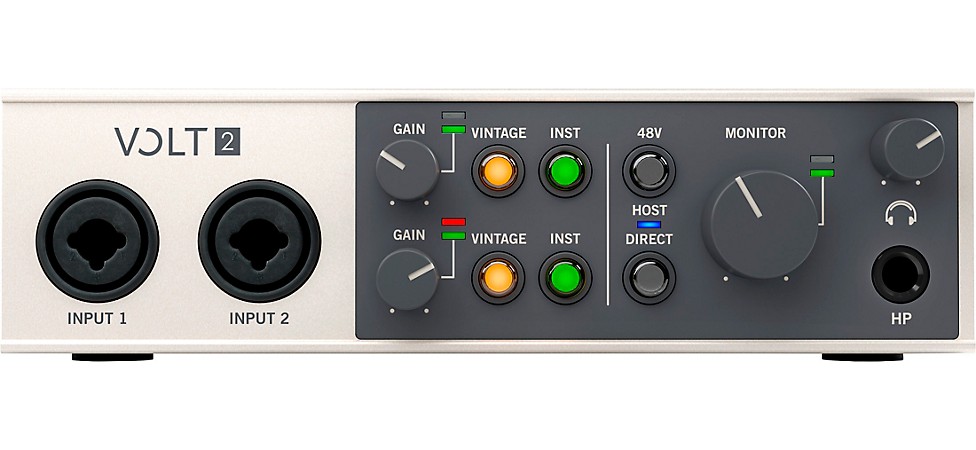
Pictured: Universal Audio Volt 2
UA has a reputation for “best-in-class” audio quality. What does that mean in terms of specs or sound in the preamp or converters? How does that translate into an audible difference for the user?
Ellis: At Universal Audio, we take a holistic system-level view. People talk about pristine converters, and this very high-quality conversion from analog into the digital realm. And if you concentrate on just that aspect of it, you're kind of missing the forest by concentrating on a couple trees.
We think about the entire product, the entire signal chain, the entire flow, of course, including those analog circuits that we put in every Volt product. In thinking about that from a quality standpoint, we’re asking if it sounds “classic,” not just how well has it been converted from analog to digital. We want to help people make their recordings sound like records. When you think about quality that way, of course, you’ve got 24-bit, it samples up to 192kHz, tons of gain on the mic preamps, so you can use dynamic mics, things like this ... but those are the trees. The forest makes your recording sound like records. Classic sound out of the box.
Can you tell us a little bit about the history of the legendary 1176 and how it made its way into the Volt?
Ellis: The 1176 limiting amplifier was created by our current CEO's father, Bill Putnam, Sr. It was designed in 1967, and released in 1968. And the interesting thing about this, and why there's this really cool direct line from that original product to what's in the Volt 176, 276 and 476, is that that original design was all solid-state electronics. It used transistors and other solid-state electronics to achieve the effects that they were going for, in terms of being a compressor and doing the job of a compressor. And a limiting amplifier, in this case.
There were many versions of this created over the years, up through the '70s. And then they changed a little bit, but it had become such a classic element used in tons of recordings that people know. The 76 was used in recording Led Zeppelin, The Rolling Stones, Michael Jackson. It's an iconic piece of equipment. There's tons more information on our website, so if folks want to, there's plenty of great information to learn about it.
So, how did that make its way into the Volt? In many ways, the 1176 limiting amplifier is easy to use. Whether you're doing a lot of compression or not, it adds a great sound.
Our engineers—keep in mind it’s the same hardware engineers and DSP engineers for all of our products—worked hard to get 1176-style analog circuitry into the Volt products.
And it kind of works the same way in that the more you drive it, it's going to react to the input level of how hard you're driving it. It doesn’t have all the controls because we wanted to keep it simple. We wanted to keep it simple and just have a few different presets. We gave three presets to users to be a guide. The first one is called “Vocal,” the second one's called “Guitar” and the third one's what we call "Fast." These are slight variations in the way that the 76 Compressor reacts to different types of input sources it might be recording.
Hopefully, people will try things, experiment, dial it in and go, "That sounds cool. Maybe it's the vocal setting on my bass guitar—that's okay. It sounds cool. Let's go.” It's a really cool direct line from that first 1176 Limiting Amplifier in 1968, all the way to the 76 Compressor circuitry inside Volt. And it's all still analog.
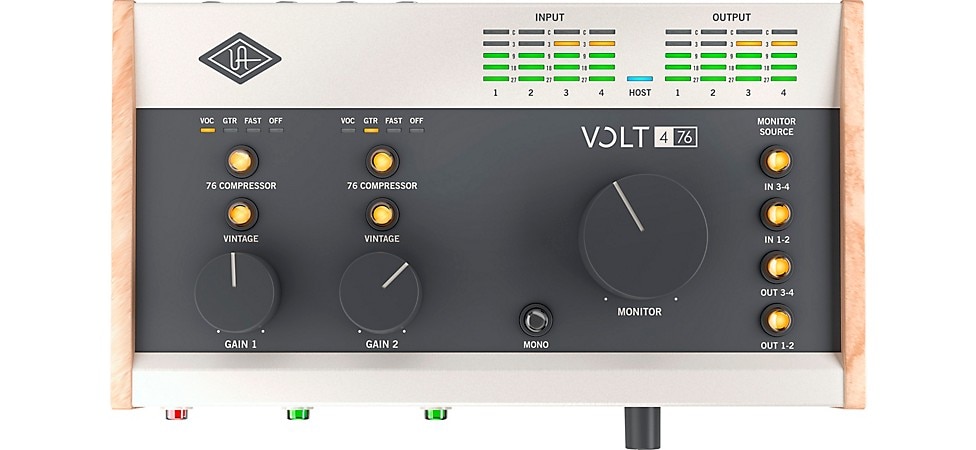
Pictured: Universal Audio Volt 476
So, with the presets, is that a mix of attack and EQ curve?
Ellis: Yeah. It's mainly around attack/release times. The difference is they kind of get faster and change slightly depending on whether it's the vocal setting, the guitar setting or the fast setting.
So, it's not a hard, fast rule what you can or should use it on, but it will give different results depending on the dynamism of your playing—how aggressive you might be playing into the Volt interface itself.
We were trying to help users achieve classic sound right out of the box, and so we felt it was really important to keep it powerful, but easy to use. We didn’t want to overload it with a bunch of controls, and this and that. That wasn't the point. The point was to get great sound fast and easy.
You get great sound—and commit to it—because it's on the track from the get-go.
Ellis: Exactly. That's right. When people think about sound quality, that's a big part of it—what’s going into your recording when you hit “record” on your computer.
Moving along the signal chain, now into the computer itself, there is a software suite that comes with these. Tell us what's included and how it works with the interface.
Ellis: We spent a long time thinking about what types of tools would be useful and helpful for users just starting out. We're really proud of the bundle of software that we were able to put together with our partners to offer to every Volt customer.
Just to run down the list, we’ve got Ableton Live Lite, which is recording software/DAW. That's where users can get going and record all their ideas. And then, there are things like Melodyne 5 Essentials from Celemony, and a variety of titles from Plugin Alliance, including Ampeg SVT VR Classic—which as a bass player, I think is pretty cool. There’s some stuff by Brainworx, tools like Masterdesk Classic, LX480 Essentials from Relab, and plug-ins from Softube and Spitfire Audio. Then there are a couple things from UJAM, namely their Deep and Dandy drum and Virtual Bassist performance software.
We figured we've got the bases covered. Maybe you're coming at this as a singer-songwriter. Maybe you're coming at this more as an electronic musician. Maybe you're coming at this as a podcaster or other content creator.
It’s safe to say there’s not just one type of user the Volt interfaces are geared toward.
Ellis: That's right. We're musicians. We make music. We record music. But we also are podcasters. We're streamers. We've got people on the team that are big into that, and so we really wanted it to be about capturing that broad user base and providing them powerful tools to make professional recordings right out of the box. I think we've definitely achieved that.
When you think about the fact that, pretty soon, thousands and thousands of people will be pouring their creativity into these devices, how does that make you feel?
Ellis: When you work hard on anything like this, lots of choices need to be made along the way, and you hope you’re making the right ones throughout. When you finally get your creation—in this case, the Volt interfaces—into the hands of users, and you hear their feedback and hear what they've created with it, it’s a proud moment. You’ve created something to help the creators, a sense of enablement, almost. It’s really cool to imagine people smiling every time they turn up the 76 Compressor or every time they touch the wood on the side of the 176.




